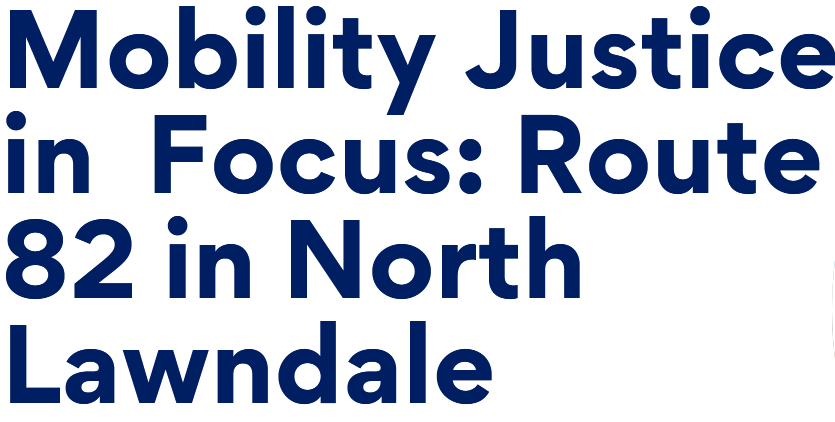This report examines Route 82, also known as the Kimball-Homan bus line, in North Lawndale on Chicago’s West Side through the lens of mobility justice to determine whether or not it is serving its ridership adequately and equitably. Mobility justice is defined by the Untokening collective as when communities are “given space and resources to envision and implement planning models and political advocacy on streets and mobility that actively work to address historical and current injustices.”1 There are a multitude of sociodemographic factors that make North Lawndale a good candidate for this study. First, the supermajority of Black residents and concentration of people with disabilities necessitates quality transit service that helps to address current and historical injustices—namely, systemic disinvestment and environmental racism.
Researchers conducted a spatial analysis of key locations and businesses in North Lawndale and their proximity to bus stops along Route 82. This analysis provided insight into the impacts of disinvestment in the study area and highlighted the crucial role Route 82 plays as a lifeline for those accessing these essential locations. Additionally, spatial analysis revealed the neighborhood’s disproportionate exposure to, and lack of protection from, environmental hazards such as nearby brownfields and excessive heat. Each of these factors underscores the need for high quality transit service.
To evaluate the current quality of service on Route 82 in North Lawndale, the project team conducted a frequency and reliability study, as well as a bus stop audit. The frequency and reliability study consists of two components: an evaluation of Route 82 performance within the Chicago Transit Authority (CTA) system and a comparison of CTA performance to that of peer agencies. Route 82, specifically when traveling through North Lawndale, performs worse in each reliability metric than the system overall. In September 2024, Route 82 had a 71.4 percent higher bunching rate, a 46 percent higher rate of large gaps between buses, and in North Lawndale, a 23.8 percent higher additional wait time than the system overall.2 The second section compares the CTA against peer agencies’ service standards. The CTA deems a route compliant to reliability standards if 65 percent of trips are delivered on-time, which is low relative to peer agencies.3 The project team used available data and geospatial analysis to determine that only nine percent of all routes were in compliance with the agency’s own service standards for on-time performance in 2022. In other words, only nine percent of all CTA bus routes delivered at least 65 percent of passenger trips on time. The project team found that the CTA has relatively high standards for bus service frequency, especially for Key Routes, which have headway standards of 10 minutes during peak service hours.4 However, according to the agency’s own on-time performance data, only 54 percent of passenger trips were delivered on time systemwide in 2022.5 This measure of reliability is the lowest of all researched agencies.
Frequency and reliability are important components of service quality and accessibility; however, the presence of amenities at bus stops can lighten the burdens of excess wait times and even shift riders’ perceptions of those wait times. The second component of this report, a bus stop audit, examines all 22 bus stops in North Lawndale along Route 82 to determine if the route meets Americans with Disabilities Act (ADA) compliance and provides adequate shelter, safety, and quality. Only two of the 22 stops audited met all the projects’ criteria for an ideal bus stop. A signal, a shelter structure, benches, tree covers/shade, or a trash can were each present at less than 50 percent of stops. However, all bus stops had curb cuts, sidewalks, and traffic ramps. Overall, bus stops were physically accessible but did not have the health and safety amenities that would bolster the bus riding experience. North Lawndale bus stops on Route 82 are equipped with the bare minimum to allow them to be accessible, but the project team found that much more could be done to ensure North Lawndale riders feel safe and comfortable waiting for the bus, especially given the findings of the previous section.
The purpose of this report is to establish current conditions along Route 82 The results show that Route 82 in North Lawndale is an important service for residents, but lacks adequate service delivery and bus stop amenities. Further study is needed on riders’ and bus drivers’ experiences on the route, especially relating to factors impacting reliability. While this report does not offer specific recommendations, it should serve as a guide and call to action to transit agencies, professionals, and activists with recognition of funding constraints and infrastructure ownership issues.
Continue Reading: Introduction: Background
